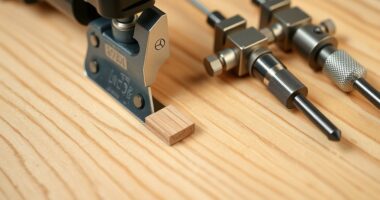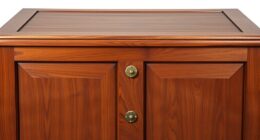Choosing the right power saw depends on your project needs. Use a circular saw for straight cuts through wood, metal, or plastic quickly. Opt for a jigsaw when making curves or intricate details. If you need precise crosscuts or angles, a miter saw is ideal. Each saw type offers unique advantages, so selecting the right one guarantees your job goes smoothly and safely. Keep going to discover how to match blades and safety tips for each.
Key Takeaways
- Circular saws are ideal for straight cuts through large materials like wood or metal, making them suitable for framing and rip cuts.
- Jigsaws excel at intricate, curved, or detailed cuts, perfect for custom shapes and complex designs.
- Miter saws provide precise crosscuts and angled cuts, ideal for framing, molding, and trim work.
- Choose the saw type based on project complexity, cut precision needed, and material size.
- Consider safety features and blade compatibility to ensure efficient and safe operation of your chosen saw.

Selecting the right power saw can substantially improve your cutting projects, whether you’re a DIY enthusiast or a professional. With so many options available, choosing between a circular saw, jigsaw, or miter saw depends on your specific needs. Each type offers different blade types suited for various tasks, so understanding these differences is essential. For instance, circular saws typically use a large, circular blade designed for straight cuts through wood, metal, or plastic. Jigsaws, on the other hand, employ a narrow, reciprocating blade that allows for intricate cuts, curves, and detailed work. Miter saws feature a blade mounted on a pivoting arm, ideal for precise crosscuts and angled cuts on boards.
When selecting a power saw, you should consider the blade types compatible with each tool. Circular saw blades come in different diameters and tooth configurations, affecting cut quality and speed. For example, fine-tooth blades produce smoother cuts, perfect for finishing work, while coarse blades cut faster but leave rougher edges. Jigsaw blades also vary, with some designed for wood, others for metal or plastic, so pick the right type based on your project. Miter saw blades tend to be universal but should be matched to the material you’re cutting to maximize efficiency and safety. Always make sure you’re using blades that are compatible with your saw and suitable for your task.
Additionally, understanding the blade types and their specific applications can help you select the most efficient and safe tools for your projects. Safety precautions are equally essential when working with power saws. Always wear appropriate protective gear, including safety glasses, ear protection, and dust masks if necessary. Before you start, inspect your saw and blades for damage or wear, replacing any dull or cracked blades. Secure your material firmly to prevent slipping, and keep your hands clear of the blade path. Never force a cut; let the saw do the work at its own pace. When using a circular saw or miter saw, make sure the blade guard is in place and functioning correctly. For jigsaws, hold the saw firmly and guide it steadily to avoid kickbacks or uneven cuts. Also, keep your workspace clean and free of debris to reduce hazards.
Understanding the differences in blade types and following necessary safety precautions will help you make informed choices and operate your tools confidently. Whether you need the power and speed of a circular saw, the detail-oriented flexibility of a jigsaw, or the precision of a miter saw, selecting the right tool with the proper blades and safety measures guarantees your project goes smoothly and safely.
Frequently Asked Questions
Can I Use a Circular Saw for Detailed Cuts?
You can use a circular saw for detailed cuts, but it’s not ideal due to its blade precision and cutting speed. Circular saws excel at straight, fast cuts but lack the control needed for intricate work. If you need detailed, accurate cuts, consider a jigsaw or miter saw instead. They offer better maneuverability and precision, helping you achieve cleaner results with less effort.
Which Saw Is Safest for Beginners?
You should choose a jigsaw for safety if you’re a beginner. It offers better control and precision, reducing risks. Follow safety precautions like wearing eye protection, keeping your hands away from the blade, and working on a stable surface. Beginner tips include starting with softer materials and practicing simple cuts. This approach helps you build confidence while minimizing accidents, making the jigsaw the safest option as you learn power saw use.
How Do Blade Types Affect Saw Performance?
Blade types greatly influence your saw’s performance by affecting blade compatibility and cutting speed. For example, a fine-tooth blade offers smoother cuts on delicate materials, while a coarse blade cuts faster through thicker, rougher surfaces. Choosing the right blade ensures compatibility with your saw and optimizes cutting speed. Always match blade type to your project needs, and you’ll achieve cleaner, more efficient results with less effort.
Are Cordless Models as Powerful as Corded Ones?
Think of cordless models like a nimble marathon runner versus a powerful sprinter; they’re portable but may lack the sustained power of corded saws. While advances in battery efficiency have closed the gap, corded saws still generally offer superior power comparison for heavy-duty tasks. However, for light to moderate work, cordless models are impressive and convenient, providing enough power without being tethered.
What Maintenance Is Required for Each Saw Type?
You need to regularly check blade durability and replace blades when they become dull to guarantee clean cuts. For motor maintenance, keep vents clear of dust and debris to prevent overheating. Lubricate moving parts as recommended by the manufacturer, and inspect power cords for damage. Proper maintenance extends your saw’s lifespan, maintains cutting efficiency, and keeps safety features functioning correctly. Regular upkeep is essential regardless of whether you’re using a circular, jigsaw, or miter saw.
Conclusion
When selecting the right power saw, consider your project needs and experience. Did you know that circular saws are used in over 70% of professional carpentry projects for their speed and precision? Whether you choose a circular saw for straight cuts, a jigsaw for intricate designs, or a miter saw for angles, pick the tool that fits your tasks. With the right saw, you’ll complete your projects efficiently and confidently.









